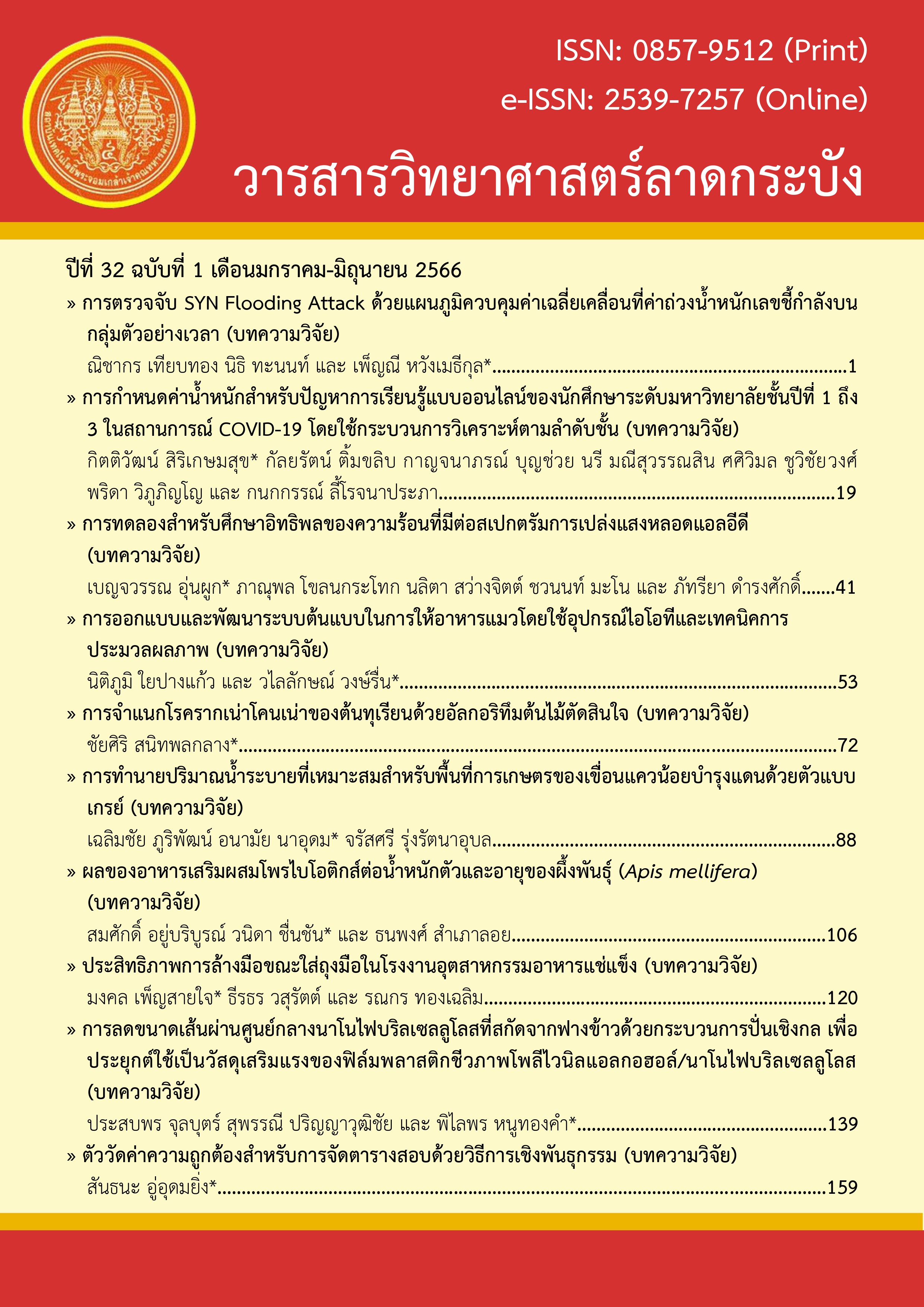การจำแนกโรครากเน่าโคนเน่าของต้นทุเรียนด้วยอัลกอริทึมต้นไม้ตัดสินใจ
Main Article Content
บทคัดย่อ
ปัญหาสำคัญในการผลิตทุเรียนคือการระบาดของโรค โดยเฉพาะโรครากเน่าโคนเน่าของต้นทุเรียนเป็นโรคที่สำคัญที่สุด เนื่องจากโรคนี้สามารถทำให้ต้นทุเรียนที่โตเต็มที่และให้ผลผลิตยืนต้นตายได้ ปัญหาที่กล่าวมาข้างต้นนั้นจำเป็นเร่งด่วนในการหาทางช่วยเหลือ การวิจัยนี้จึงมีวัตถุประสงค์เพื่อพัฒนาโมเดลการจำแนกโรครากเน่าโคนเน่าของต้นทุเรียนโดยใช้อัลกอริทึมต้นไม้ตัดสินใจภายใต้กระบวนการเรียนรู้ของเครื่อง จากข้อมูลเกษตรกร 50 ราย ในตำบลนาสัก อำเภอสวี จังหวัดชุมพร โดยมีข้อมูลตัวอย่างสำหรับเรียนรู้จำนวน 500 รายการ แบ่งออกเป็นสองกลุ่ม ได้แก่ รายการที่เป็นโรครากเน่าโคนเน่าจำนวน 150 รายการ และรายการปกติจำนวน 350 รายการ ซึ่งถูกเรียกว่า คลาส 1 และคลาส 0 ตามลำดับ สมดุลข้อมูลด้วยวิธีการสังเคราะห์ข้อมูลเพิ่ม (Synthetic Minority Oversampling Technique: SMOTE) และกระบวนการเรียนรู้ของเครื่องด้วยอัลกอริทึมต้นไม้ตัดสินใจ (Decision Tree: DT) ในการจำแนกข้อมูล พบว่า มีความถูกต้อง 99.33 % ซึ่งมีประสิทธิภาพสูงสุด เมื่อเปรียบเทียบความถูกต้องกับอัลกอริทึมแรนดอมฟอเรสต์ (Random Forest: RF) อัลกอริทึมซัพพอร์ตเวกเตอร์แมชชีน (Support Vector Machine: SVM) และอัลกอริทึมเพื่อนบ้านใกล้ที่สุด (K-Nearest Neighbors: KNN) ที่มีความแม่นยำเป็น 95.33 % 93.66 % และ 91.33 % ตามลำดับ และค้นพบว่า ลักษณะอาการโรครากเน่าโคนเน่าที่มีประสิทธิภาพจำแนกว่าเป็นโรครากเน่าโคนเน่า 3 ลักษณะแรก คือ เนื้อไม้สีน้ำตาล แผลเน่าลุกลามไว และกลิ่นหืนในส่วนที่เน่า
Article Details

อนุญาตภายใต้เงื่อนไข Creative Commons Attribution-NonCommercial-NoDerivatives 4.0 International License.
เอกสารอ้างอิง
วันดี กฤษณพันธ์. 2541. สมุนไพรน่ารู้. พิมพ์ครั้งที่ 3, สำนักพิมพ์แห่งจุฬาลงกรณ์มหาวิทยาลัย, กรุงเทพมหานคร. [Wandee Gritsanapan. 1998. Interesting herbs to know. 3td ed, Chulalongkorn University Publisher, Bangkok. (in Thai)]
สำนักงานเศรษฐกิจการเกษตร. 2564. สารสนเทศเศรษฐกิจการเกษตรรายสินค้าปี 2564. สำนักงานเศรษฐกิจการเกษตรกระทรวงเกษตรและสหกรณ์ เอกสารสถิติการเกษตรเลขที่ 402 แหล่งข้อมูล : https://www.oae.go.th/assets/portals/1/files/jounal/2565/commodity2564.pdf. สืบค้นเมื่อวันที่ 20 มิถุนายน 2565.
อมรรัตน์ ภู่ไพบูลย์. 2557. โรครากเน่า โคนเน่า และโรคผลเน่าของทุเรียน. กรมวิชาการเกษตร, แหล่งข้อมูล : https://www.doa.go.th/share/. ค้นเมื่อวันที่ 25 มิถุนายน 2565.
Bawack, R. E., Wamba, S. F., & Carillo, K. D. A. 2021. A framework for understanding aritificial intelligence research: insights from practice. Journal of Enterprise Information Management, 34(2), 645-678.
นพรัตน์ นนท์ศิริ. 2022. การจำแนกข้อมูลเพื่อวินิจฉัยความเสี่ยงการเป็นโรคเบาหวานโดยใช้เทคนิควิธีแบบร่วมกันตัดสินใจและวิธีเลือกคุณลักษณะเด่นไปข้างหน้า. วารสารวิทยาศาสตร์และเทคโนโลยี มหาวิทยาลัยราชภัฏอุดรธานี, 10(2), 107-122. [Nonsiri N., Chaichitwanidchakol P. and Somkantha K. 2022. Data Classification for Diabetes Risk Diagnosis using Majority Voting Ensemble Method and Forward Feature Selection Method. Udon Thani Rajabhat University Journal of Sciences and Technology, 10(2), 107-122. (In Thai)]
ณัฐวดี หงษ์บุญมี และ ประภาศิริ ตรีพาณิชย์กุล. 2019. การเปรียบเทียบประสิทธิภาพการจำแนกข้อมูลเพื่อวิเคราะห์ปัจจัยความเสี่ยงที่ส่งผลต่อการ เกิดโรคไฮเปอร์ไทรอยด์ด้วยเทคนิคเหมืองข้อมูล. วารสารวิทยาการและเทคโนโลยีสารสนเทศ, 9(1), 41-51. [Hongboonmee, N., & Trepanichkul, P. 2019. Comparison of Data Classification Efficiency to Analyze Risk Factors that Affect the Occurrence of Hyperthyroid using Data Mining Techniques. Journal of Information Science and Technology, 9(1), 41-51. (In Thai)]
นฤมล ชูเมือง. 2021. การจำแนกสถานะทารกในครรภ์โดยการใช้เครื่องมือติดตามอัตราการเต้นของหัวใจและการหดรัดตัวของมดลูกด้วยเทคนิค ต้นไม้ตัดสินใจ. วารสารวิทยาศาสตร์เทคโนโลยีและนวัตกรรม, 2(4), 36-46. [Chumuang N. 2021. Fetal Status Classification with Heart Rate Tracker and CTG by using Decision Tree. Journal of Science Technology and Innovation (STIJ). 2(4), 36-46. (In Thai)]
อัจฉรา สุมังเกษตร และณัฐวุฒิ ศรีวิบูลย์. 2021. ระบบผู้เชี่ยวชาญการใช้สมุมไพรรักษาโรคบนฐานความรู้ภูมิปัญญาสุขภาพด้วยเทคนิคการจำแนกข้อมูลแบบต้นไม้ตัดสินใจ. วารสารศรีปทุมปริทัศน์, 13(1), 115-127. [Achara Sumungkaset and Nattavut Sriwiboon. 2021. The Expert System for Herbs Usage Based on Wisdom-Knowledge in Terms of Health Using Tree Classification Decision Techniques. Sripatum Review of Science and Technology, 13(1), 115-127. (In Thai)]
Somvanshi, M., Chavan, P., Tambade, S., & Shinde, S. V. 2016. A review of machine learning techniques using decision tree and support vector machine. In 2016 international conference on computing communication control and automation (ICCUBEA) , IEEE Pune Section, Pune, India. 1-7.
Fernández, A., Garcia, S., Herrera, F., & Chawla, N. V. 2018. SMOTE for learning from imbalanced data: progress and challenges, marking the 15-year anniversary. Journal of artificial intelligence research, 61, 863-905.
Chawla, N. V., Bowyer, K. W., Hall, L. O., & Kegelmeyer, W. P. 2002. SMOTE: synthetic minority over-sampling technique. Journal of artificial intelligence research, 16, 321-357.
Maldonado, S., Vairetti, C., Fernandez, A., & Herrera, F. 2022. FW-SMOTE: A feature-weighted oversampling approach for imbalanced classification. Pattern Recognition, 124, 108511.
Pyle, D. 1999. Data Preparation for Data Mining. Morgan Kaufmann Publishers, United States of America.
Brownlee, J (Jason Brownlee). 2022. Data Preparation for machine learning. Available at:http://14.99.188.242:8080/jspui/bitstream/123456789/14557/1/Data_Preparation_for_Machine_Learning_Data_Cleaning_C_Feature_Selection_C_and_Data_by_Jason_Brownlee.pdf.
Wang, H., Hsu, H., Diaz, M., & Calmon, F. P. 2021. To split or not to split: The impact of disparate treatment in classification. IEEE Transactions on Information Theory, 67(10), 6733-6757.
Rácz, A., Bajusz, D., & Héberger, K. 2021. Effect of dataset size and train/test split ratios in QSAR/QSPR multiclass classification. Molecules, 26(4), 1111.
Loh, W. Y., & Shih, Y. S. 1997. Split selection methods for classification trees. Statistica sinica, 7(4), 815 - 840.
. Lin, C. L., & Fan, C. L. 2019. Evaluation of CART, CHAID, and QUEST algorithms: a case study of construction defects in Taiwan. Journal of Asian Architecture and Building Engineering, 18(6), 539-553.
Kesornsit, W., Lorchirachoonkul, V., & Jitthavech, J. 2018. Imbalanced data problem solving in classification of diabetes patients. Khon Kaen University Research Journal, 18(3), 11-21.
Rokach, L., & Maimon, O. 2005. Top-down induction of decision trees classifiers-a survey. IEEE Transactions on Systems, Man, and Cybernetics, Part C (Applications and Reviews), 35(4), 476-487.
Stehman, Stephen V. 1997. Selecting and interpreting measures of thematic classification accuracy. Remote Sensing of Environment, 62 (1), 77–89.
ชัยศิริ สนิทพลกลาง และ สัตวัฏฏ์ คำศิริ. 2021. การจำแนกผู้สมัครที่ลังเลในการ ตัดสินใจศึกษาต่อเพื่อสร้างกลยุทธ์สนับสนุนการตัดสินใจให้เข้าศึกษาต่อ กรณี ศึกษามหาวิทยาลัยราชภัฏจันทรเกษม. วารสารวิทยาศาสตร์ลาดกระบัง, 30(2), 58-73. [Sanitphonklang, C., & Kumsiri, S. 2021. Identification of Applicants Who are Hesitant to Decide to Study in Order to Create Strategies to Support Decision-making for Admission Case Study of Chandrakasem Rajabhat University. Journal of Science Ladkrabang, 30(2), 58-73. (In Thai)]

